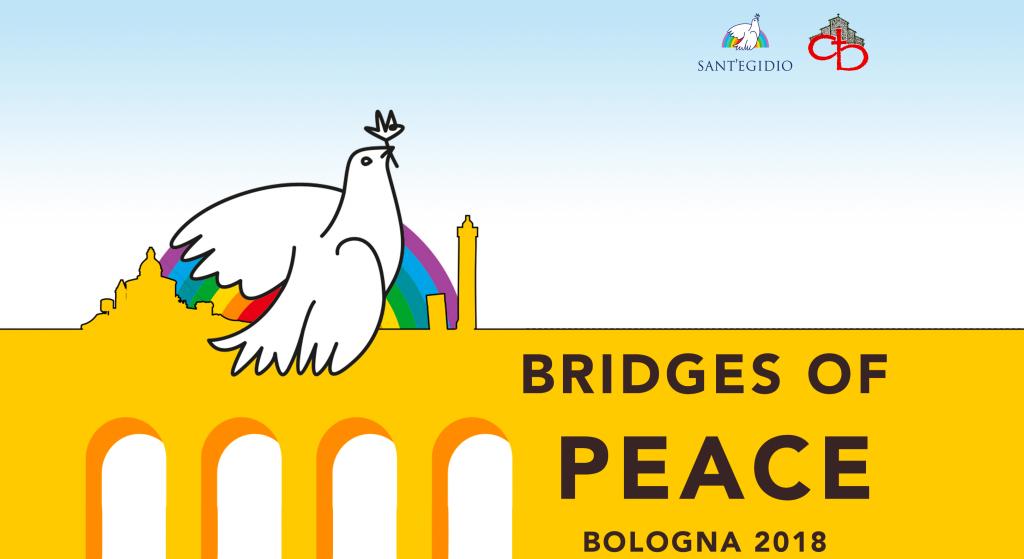The stylized arches of the logo, representing the 32nd edition of the International Meeting in the Spirit of Assisi, recall the porticos of Bologna, the city that, as Archbishop Matteo Zuppi says, “has in itself the genes of meeting, it has been and continues to be the crossroads of peoples and cultures.” The 32nd event is being held in Bologna, October 14-16, 2018.
In the message Pope Francis sent to the participants he also recalls the “the city’s singular architecture,” which invites visitors to “create connections that lead to real encounters, bonds that unite, ways that lead to overcoming conflicts and harshness.”
Thus, after 32 years, “Bridges of Peace” continues — according to Andrea Riccardi — to unwind the uninterrupted thread of the dialogue begun at Assisi by John Paul II in October of 1986, at the time of the Cold War. It is a dialogue that passed through different, difficult, bellicose, hostile scenarios but also of unexpected pacts.”
It seems almost futile to note how much the world and the anthropological scenario have changed since then. What Riccardi describes as the “euphoria of globalization,” almost the prefiguration of a “global belle epoque,” has failed in its objective because “a spiritual unification was lacking to fulfill the dialogue.” The religions themselves frequently did not perceive globalization as an adventure of the spirit,” so much so that not only has “the global world not brought peace,” but “it has produced terrible wars, as in Syria, which has lasted since 2011” (the Syro-Orthodox Patriarch of Antioch Ignatius Aprhem II, spoke emotionally about it), and “the war of religion and religious violence have been legitimized.” Yet “the religions are innocent of the blood that is shed in the name of this or that “ religion, said the Grand Imam of Al-Azhar. Ahmad Al-Tayyeb: “Terrorism can’t be the work of a believing people; instead, it is born from the trade of consciences and arms.”
However, problems aren’t lacking even where arms are silent. “In a difficult moment — in which sometimes many networks of living together in the peripheries of the large cities fall and walls are raised not only between Europe and Africa, to defend oneself from migrants, but also between European countries –, bridges of peace must be reconstructed together, explained the President of Sant’ Egidio Community, Marco Impagliazzo.
Beginning today and for the next three days, up to the great Prayer for Peace in Piazza Maggiore, preceded by the prayers that the representatives of the different religious traditions will recite in various places of the city, thousands of women and men of faith will seek to re-tie the thread of a hope that vacillates because, says Riccardi, “many fears linger in the hearts of people who seek reassurance even opposing themselves as a tribe against the other enemy <tribe>. Greeting all and thanking the President of Sant’Egidio Marco Impagliazzo, Archbishop Zuppi described it as “a caravan of men and women of different faiths, of persons of good will, who have become a network of friendship and true communication, a reserve of good air and relations in a world polluted by so much intolerance and in which it is so hard to understand one another.”
Also speaking on October 14, 2018, in the opening assembly in the Palace of Congresses of the Bologna Fair, were the President of the European Parliament, Antonio Tajani; the Grand Imam of Al-Azhar, Ahmad Al-Tayyeb; the Chief Rabbi of France, Haim Korsia; the former President of the European Commission, Romano Prodi (“Solidarity is built here, which is a condition for peace”). The tragedy of the war in Syria was testified by Nour Essa, Syrian refugee in Italy, who arrived in Rome with her family two years ago together with other refugees in the plane that brought Pope Francis back from the Island of Lesbos and who were then received by Sant’Egidio Community along with the other 1,700 refugees fleeing from famine and war, through the humanitarian corridors that are also bridges of peace.
Thirty-four panels are planned over the three days of study and work, all characterized by a choice of openness and dialogue, because “with dialogue, the shards of the world, dangerous atoms, and broken bridges are repaired” (Andrea Riccardi). This year the meeting coincides with Sant’Egido’s 50th anniversary, a Community that for 32 years has promoted international events in the “spirit of Assisi,” and with that of ’68, which will be recalled in a panel by some of its leaders. Among other issues that will also be addressed is “Europe and its Crisis,”” solidarity between the generations, inter-religious dialogue, the environment, disarmament, the role of believers in face of wars, the widespread violence in Latin America, the future of Africa and John Paul II exactly 40 years (October 16, 1978) from the beginning of his pontificate. Also taking part in the Bologna Meeting are three Bishops from the People’s Republic of China: Joseph Shen Bin, Bishop of Haimen; Antony Dang Mingyan, Bishop of Xi’an and Joseph Yang Yongqiang, Bishop of Zhoucun.

Bologna Conference: Bridges of Peace, Humanitarian Porticos and Corridors
The Spirit of Assisi Starts from Bologna in the Name of the Dialogue Between Religion and Culture


